

设计单位 上海可空建筑设计工作室
项目地点 福建南平
建成时间 2024.8
建筑面积 1222.4平方米
本文文字由设计单位提供。
大布村是位于福建与浙江接壤山区中的一个古朴村落。村落沿松溪而起,浙闽水路航运留下了村落伸向河道的码头步道。如今沿河一线的建筑仍基本保留历史旧貌,记录着未曾间断的历史痕迹。本项目是针对其中一组进行的更新与改造,力图在尊重和保护历史痕迹的同时,以新的结构与空间形式,探索传统村落中的当代空间价值。
Dabu village located in mountain area between Fujian and Zhejiang province. Shipping trade alone Songxi river created the village where we can still find old pier remains extend to the river. The old houses along the river still keep the historical features recording the uninterrupted traces of history. The project is the renovation of one group of these houses. We try to present contemporary space quality and value by balance the preservation of historical features and introduction of new structure and spaces.




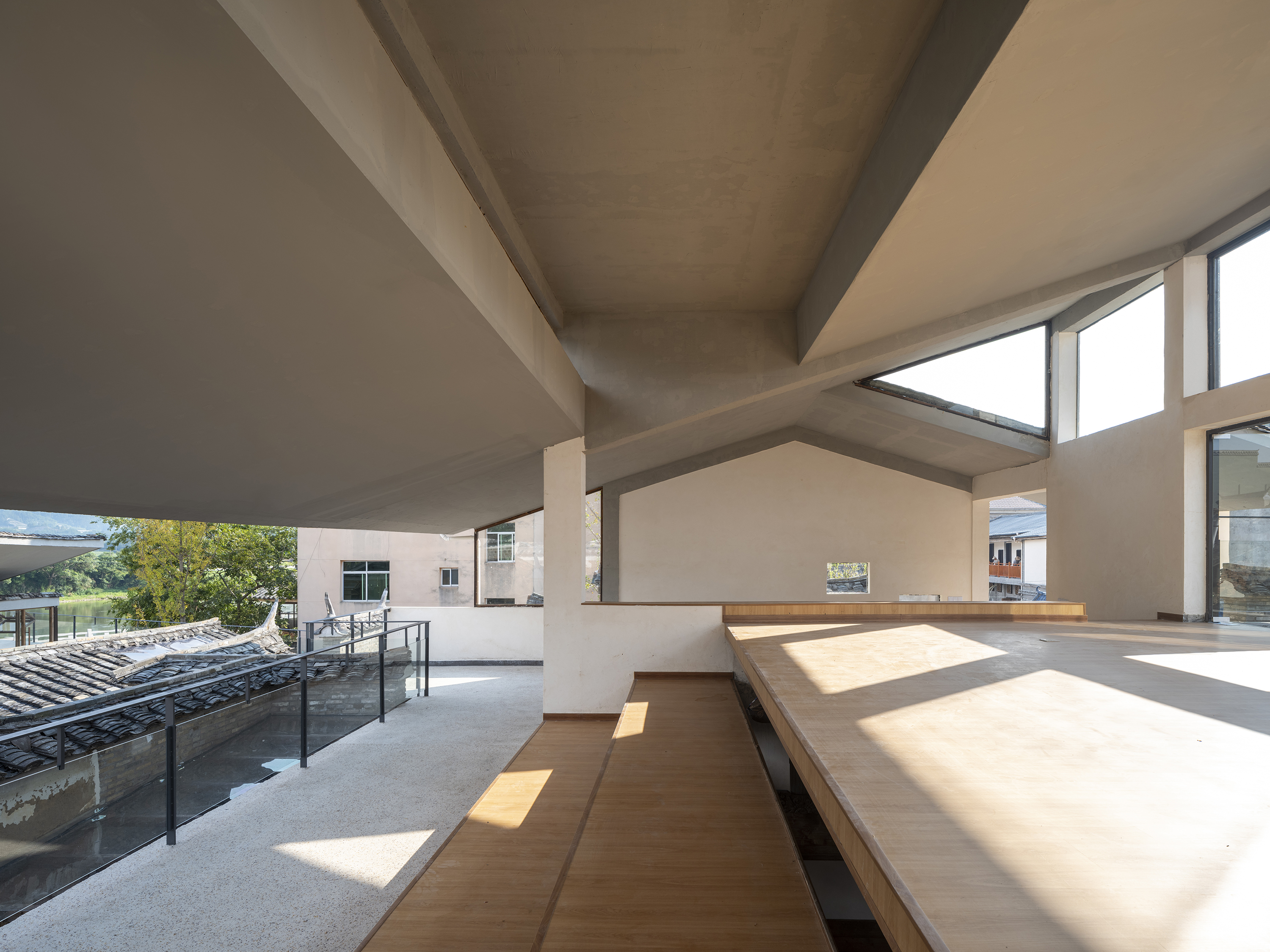

乡村制造
不同于收储资产并进行功能置换的常见开发逻辑,本项目是政府出资并主导的闲置宅院自主更新。这种模式下宅院权属与功能不变,仅以租赁的形式交由政府统一更新,并作为乡村公共空间使用管理。这种方式增强了更新的可操作性,但权属与功能的模糊状况亦造成了设计与建设的复杂和矛盾,加上成本有限,而施工又以经验建造为主,这使本项目成为始终围绕乡村状况的“乡村制造”,它既是挑战,又具有启发性。
Different from regular renovation development, this project follows the mode of autonomous renovation funding and leading by the government. The ownership and functions remain unchanged, only under the unified management of the government in the form of leasing. This mode enhanced the operability of the renovation, but also create complex situations to the design and construction due to ambiguous ownership and function situations. In addition, the cost is limited, and the construction is mainly based on experience construction.This make the project a “Made in village” project which always surrounding by special village situations. It is a challenge but also inspiring.

改造范围内的建筑产权复杂分散。由于重建后的建筑理论上仍属于上述不同人家,根据乡村习俗,各户间的边界仍须以墙体或地台等永久性构件的形式标记。这使得改造设计既要打破边界将建筑群落作为整体考虑,亦须保证边界的位置和几何关系,在更新后的空间中以可被识别的方式呈现。这也要求建筑空间须在自然边界几何关系的基础上,建立合理的空间秩序并考虑空间的组合与形式,最终形成不寻常的空间复杂度。这种复杂,背后是乡村产权的自然形式,其本质则是村落的空间尺度与肌理。空间哪怕是全新建造,也不会成为村落中的异质。
The ownerships of houses are complex and scattered. Since the reconstructed buildings theoretically still belong to different families, according to rural customs, the boundaries between households must still be marked by permanent components such as wall or platform. This makes the renovation design need not only to consider the building community as a whole, but also to make sure that the position and geometric of the boundaries will be presented in a recognizable way. This gives the space a unique complexity, behind this complexity is the natural form of the ownership of the village houses which essentially forms the scale and context of the village. Under the control of such complexity, the space will never be heterogeneous even if it is brand new construction.



改造中空间需求无法准确定义,空间的不断演变成为一种日常。与运营目标明晰的常规开发相比,本项目空间功能始终不明确。如说乡村的自然形式影响了建筑的尺度和形态结构,参与者对乡村公共空间的设想和理解,则动态影响着建筑的空间形式,使现场自发的调整伴随整个建造过程,空间也在这样的调整中不断演变——尽管不断脱离设计的预期,却一直以灵活的姿态反映乡村自身的期待与诉求。这种未定义和未完成的状态亦是当代乡村演变中的空间日常,一种并不要求精致完成度的松弛感,以及面向变化和新体验的开放与灵活。
Space function cannot be accurately defined while the continuous evolution becomes a daily situation. In contrast with the normal development project with clear target and function, the function and requirement of the space in this project are always unclear. Under the aim of a public culture and living space for the village, participants’ assumptions and understanding of rural public spaces dynamically affect the design and form of the space, this resulted in spontaneous adjustments on site throughout the construction process, the spaces are evolving themselves: although it continues to deviate from design expectations, it has always responded to the expectations and demands of the countryside in a flexible manner.


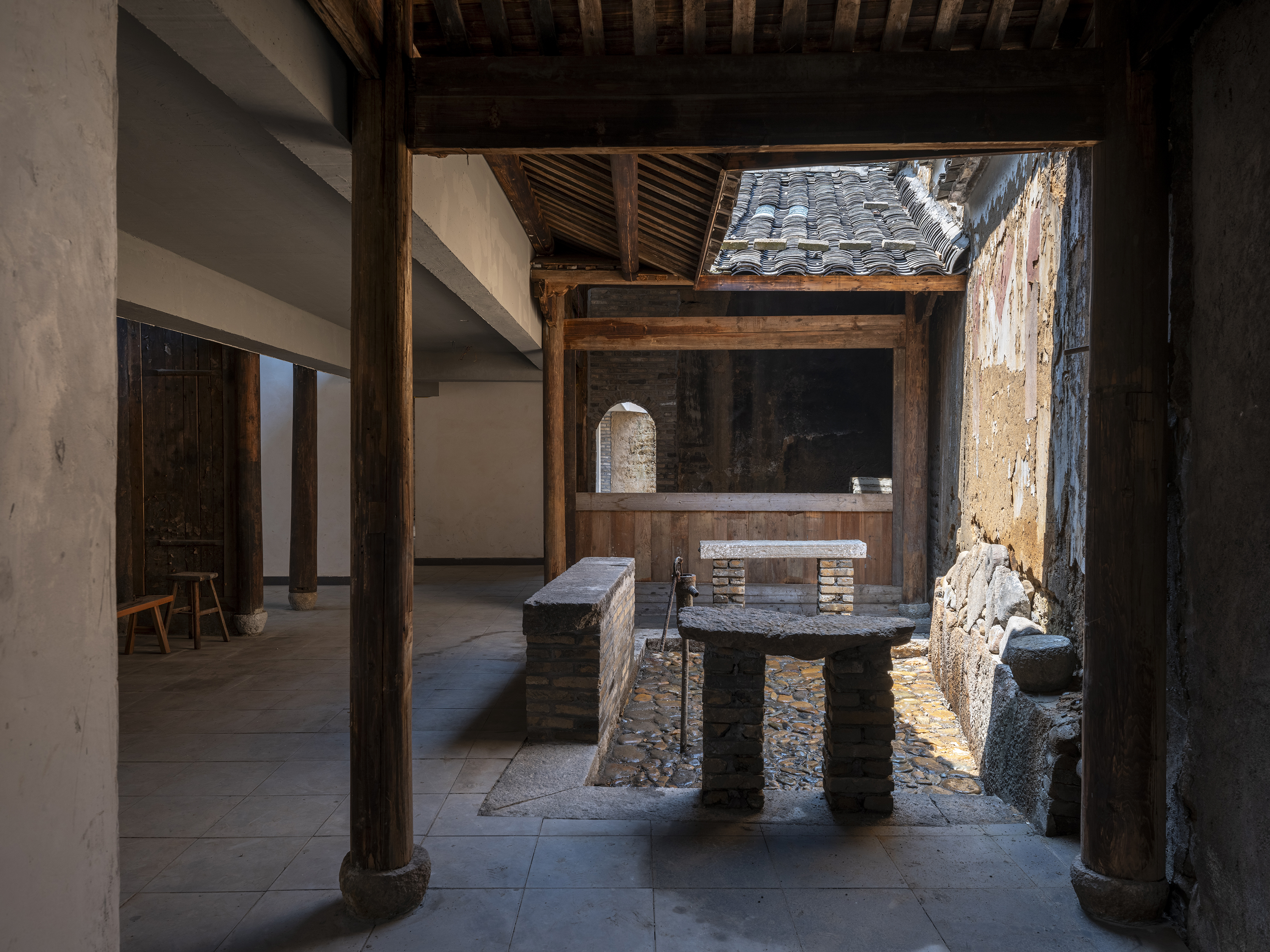

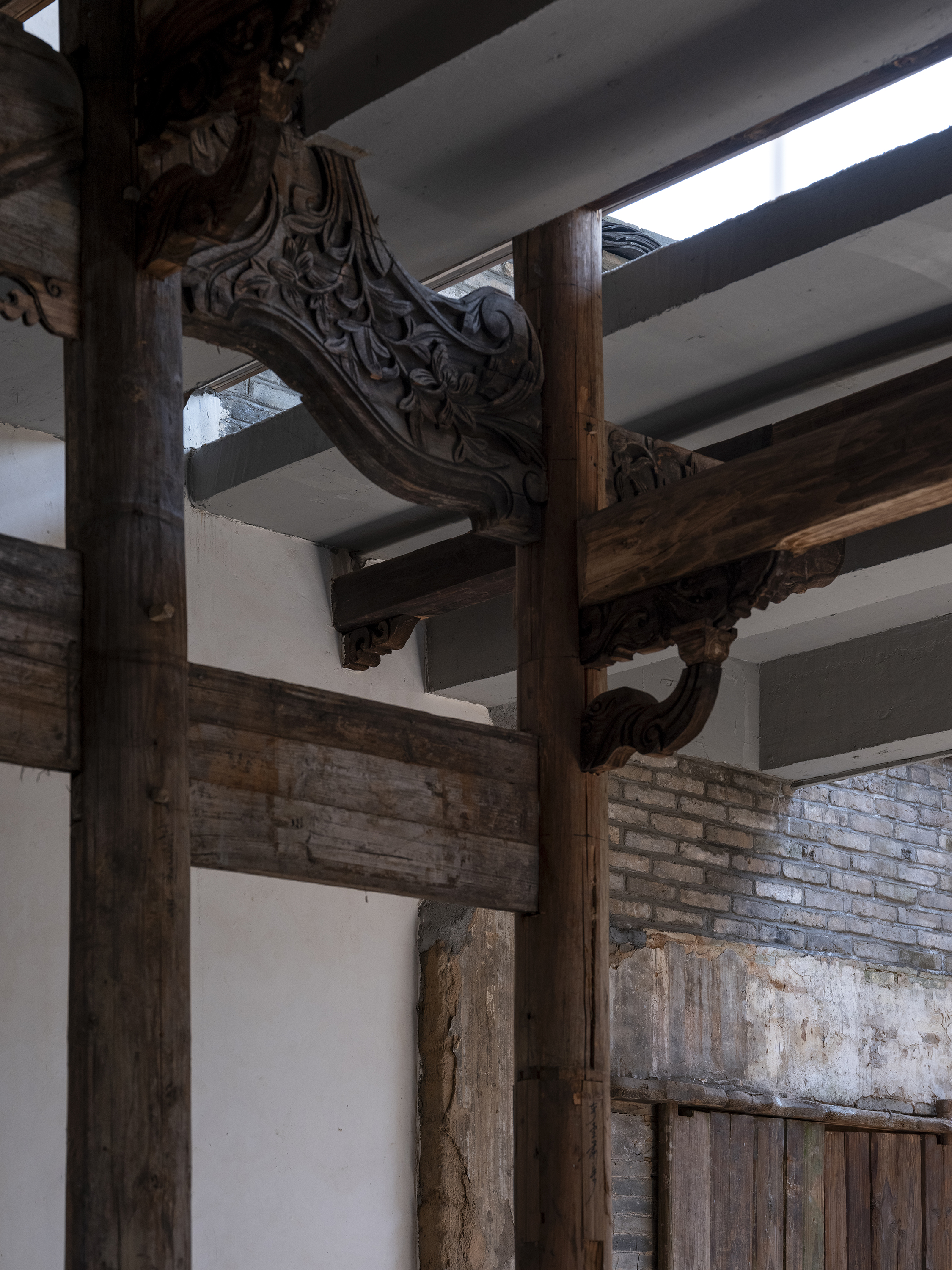
新旧交织
改造围绕新与旧的关系展开。既有建筑群落分为南北两部分,南侧以零碎的宅院构成,北侧则是夯土封火墙围合中的三路大宅。夯土墙,木构青瓦的建造体系形成了群落的传统风貌,但无论从形制,工艺或历史的视角看,这些建筑格外普通日常,不构成特殊的保护价值,加之破损坍塌情况严重,若采用历史风貌修缮如旧的方式将变成仿古新建,并不必要也并不恰当。因此总体的改造策略变为基于现状保护保留有价值的构件,并以新结构连接整合,形成新旧交织的空间体验。
The renovation design starts from dealing with new and old. The existing building complex is composed with two parts. The southern part is made up of fragmented small houses while the northern part is a complete mansion surrounding by rammed earth wall. Traditional wood frame, blue tiles and rammed earth walls formed the traditional feature of the space, however, these buildings are extremely ordinary and do not constitute special protection value no matter from the perspective of form, craftsmanship or history. Additionally, the houses are severe damage and collapse, if we try to restore the building with historical style, it will become a fake antique building which is unnecessary and inappropriate. Therefore, the overall renovation strategy is to protect and retain valuable components based on the current situation, and integrate them with new structures to form a spatial experience where the old and the new are intertwined.






针对南侧分散铺开的建筑状况,我们采用了织补链接的更新策略。去除搭建和不具备保留条件的构筑后,留下东南角和中部两幢民居建筑,以及以残垣断壁形式存在的夯土墙体。考虑不影响既有结构基础,新空间以对角错开的方式嵌入群落格局,构成新旧交替,院落和建筑穿插的均质格局。在空间内部,这种策略形成了可漫游体验的庭院式的空间群,传统木构的具体和当代空间的抽象交替,互相呈现。
We adapt the strategy of darning in the southern part corresponding to the scattered building conditions. After removing the temporary construction and buildings that do not have retention conditions, two independent traditional house and several rammed earth wall is left. Considering not affecting the existing structural foundation, the new space is embedded in the building pattern in a diagonally staggered manner, forming a homogeneous pattern of alternating old and new, interspersed courtyards and buildings. For the interior space, this strategy forms a space group with courtyards which can be roamed and experienced. The concreteness of the traditional wooden structure and the abstraction of the contemporary space alternate and present each other.

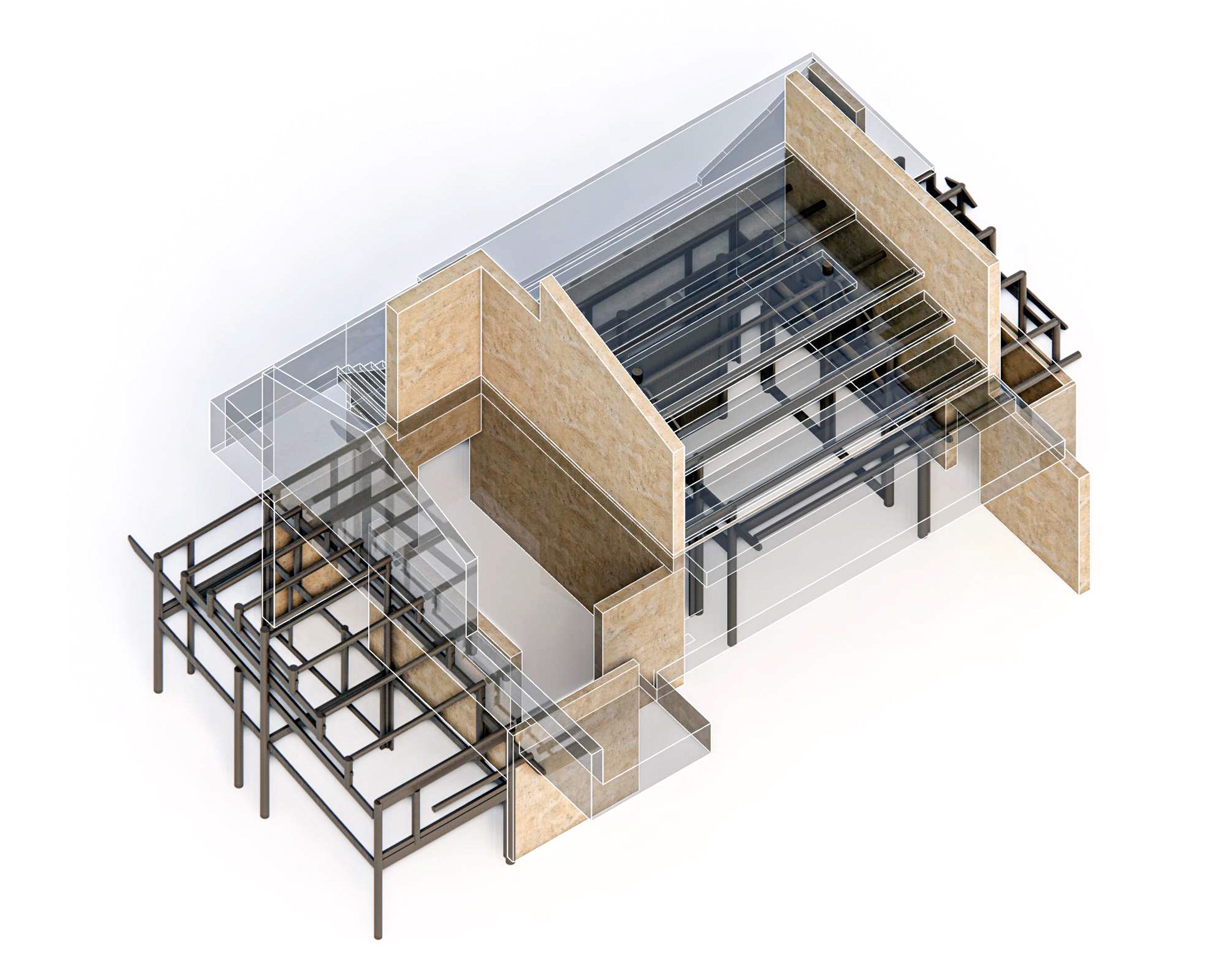
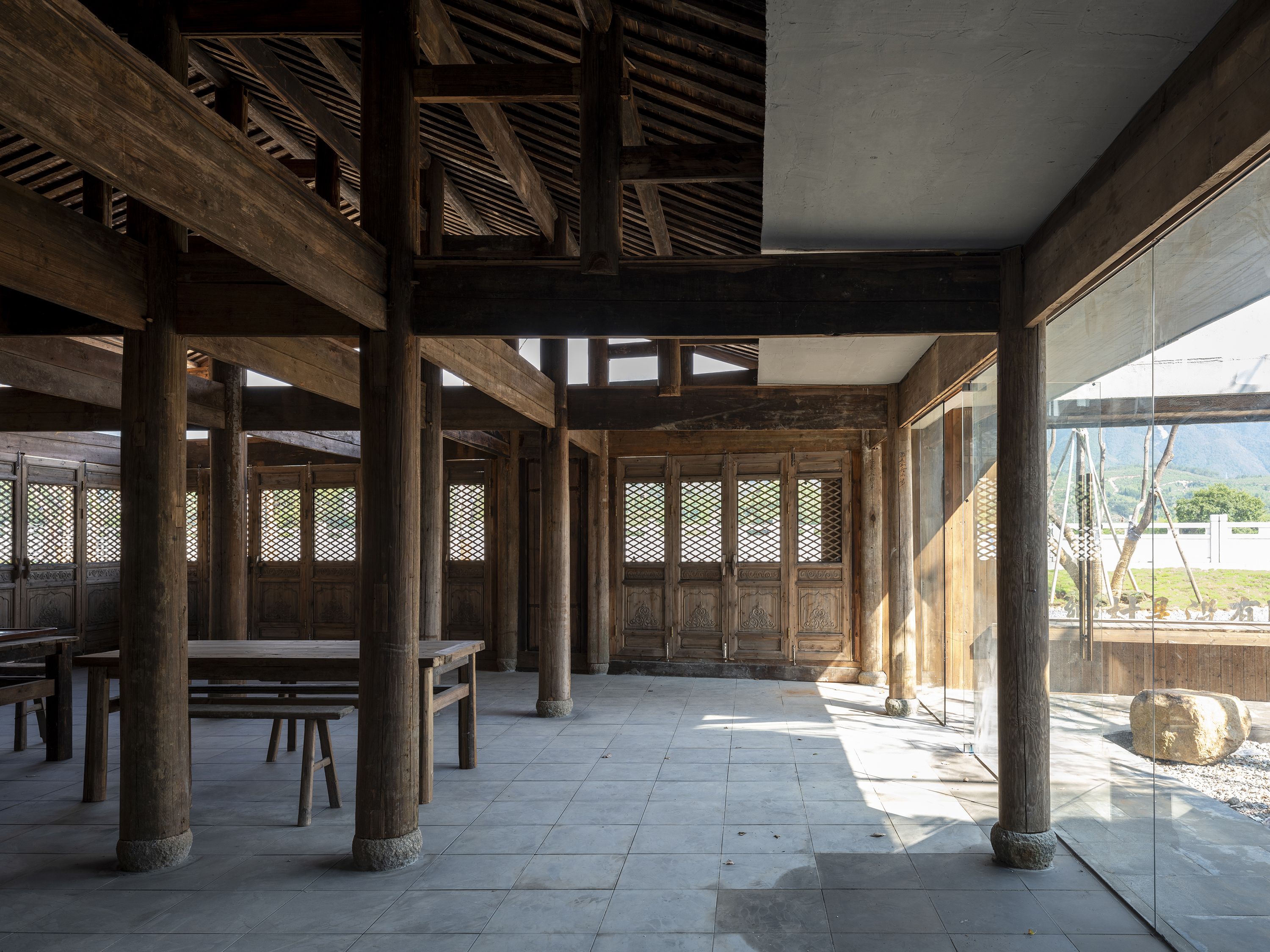





北侧宅院形制完整,夯土封火墙内,雕花木构和天井墙上的“福”字浮雕均刻画场所的历史气象,只是屋顶不复存在。针对这样的现状,我们采用了垂直生长的更新策略,在完整保留这些建筑片段的基础上,以垂直向上的新结构构筑的全新屋顶。
The northern part is complete in form with components like carved wooden structure, rammed earth walls and relief sculpture of “福“ depicting the historical atmosphere of the place. However, the roof no longer exists. We introduce a vertical structure rooted in between these components and grow above to form a new space as the roof.





此屋顶结构本身既是一层漂浮在木构墙顶之上的敞开式空间,坡顶披檐之下,横向展开的山水景致和错落的屋顶纳入视野;屋顶结构之下,厅堂空间的木构架被完整保留,屋顶空间地面顺木构檩条的位置和标高,做出面向景观供人席坐的条板大台阶,木构与新结构通过台阶的错落嵌合一体,还原木构支撑屋顶的结构力感,保留了厅堂的空间重量,而从缝隙中透露的道道光影提示结构与空间的重构,将当代体验结合进历史氛围,促成新旧交织的化学反应。
It is an open space floating on the walls and wood frames in the upper part with a horizontal view of the natural landscape and roofs. Beneath this structure the original wood structure of the house is preserved. The floor of the roof space follows the position and elevation of the wooden purlins, creating large slatted steps facing the landscape for people to sit on. The wooden frame and the new structure are integrated through staggered steps, restoring the structural strength of the wooden structure supporting the roof and retaining the spatial weight of the hall. The light and shadow revealed from the gaps prompt the reconstruction of structure and space, integrating contemporary experience into the historical atmosphere, and promoting a chemical reaction of the interweaving of the old and the new.




公共空间与集体记忆
作为大布村的文化生活空间,项目的公共属性非常重要。对乡村而言,公共体验并不在于消费场景或文化活动等常用以定义公共的概念,开放自由的空间体验本身,以及可以弥合人际的文化认同和集体记忆,即构成了乡村的公共性与松弛感。公共空间是须被准确定义的特定场所。古时的大树村口,以特定的形式赋予事件空间以形象,如今在当代语境中如何塑造恰当有效的公共空间,成为一项重要挑战。
As the cultural living space of Dabu Village, the public attributes of the project are very important. For rural areas, public experience does not lie in consumption scenes or cultural activities, which are commonly used to define public concepts, the open and free space experience itself, as well as the cultural identity and collective memory that can bridge interpersonal relationships, constitute the publicity and relaxation of the countryside. Public space is a specific place that must be accurately defined. In ancient times, the big tree by the road always forms the entrance space of a village, giving the event space an image in a specific form. Nowadays, how to create appropriate and effective public spaces in the contemporary context has become an important challenge.

除了在建筑内营造开放漫游的体验外,我们将注意力投向建筑屋顶上的户外空间。南区分散布局的西侧设置有完整的新建体量作为非遗工作坊,这一空间在室内连接分散的新旧体量,而在屋顶则以略带坡度的上人屋面和架空连桥,连接二层空间,并以衔接承托的姿态,将错落的青瓦屋面整合成极具体验感的场所。
In addition to creating an open roaming experience within the building, we turned our attention to the outdoor space on the roof. A complete new volume is set up on the west side of the dispersed layout of the southern part as an intangible cultural heritage workshop. This space connects the new and old volumes indoors, while on the roof, it connects second floor spaces by a slightly sloping walkable roof and bridge. It integrates the scattered tile roofs into a highly experiential place in a connecting and supporting posture.
上人屋面通过外部楼梯与村落自然衔接,形成了一个不受建筑开放时间限制的乡村公共空间,一个漂浮在屋顶之间的小型广场。在这里既可以近距离触摸风蚀的夯土墙,又可以爬上面向山水景观的瓦屋面,乡村习以为常的元素被新的体验重新定义。
This roof space is naturally connected to the village through external stairs, forming a rural public space that is not restricted by the opening hours of the building: a small square space floating between the roofs. Here you can touch the wind-eroded rammed earth walls up close, and you can climb up the tile roofs facing the landscape. The common elements of the countryside are redefined by new experiences.



在屋面的一端,一座越过街道悬挑向河流的天桥,将屋顶空间引向景观的远眺,这唯一能环视村落与山水的视角使这个空间具备了属于村落的特殊性与标志性,也具备了特有的公共性。
At one end of the roof, a sky bridge cantilevers over the street towards the river, directing the roof space to the distant view of the landscape. This is the only perspective from which one can look around the village and the landscape, giving this space the particularity and iconicity of the village, as well as its unique public character.
桥梁白色的拱形曲线桥墩,以超脱村落风貌尺度的特殊形式,在街口河边构筑了一个当代的标志物,成为村落新的集体记忆。当我们远眺,这座桥和历史上村落延伸至河道的条条堤道码头一样,以连接自然与村庄的线性形式,延续着向河而居的村庄文化记忆。
The white arched curved piers of the bridge, in a special form that transcends the scale of the village, build a contemporary landmark by the river at the street entrance and become a new collective memory of the village. If we look at it from a distance, this bridge is just like the causeway piers that historically extended villages to the river in the same linear form, continuing the cultural memory of the village living towards the river.



设计图纸 ▽





完整项目信息
项目名称:松溪大布村文化生活空间
项目类型:建筑/乡建/古宅更新
项目地点:福建省南平市松溪县大布村
设计时间:2023.10—2023.12
建设时间:2024.1—2024.8
用地面积:1600平方米
建筑面积:1222.4平方米
设计单位:上海可空建筑设计工作室
联系方式:cocoonstudio@126.com
主创建筑师:王伟实
设计团队:
建筑设计:王伟实;王翌旸(实习);陆泓澎(实习)
结构设计:陈学剑
暖通机电设计:钱薇
顾问咨询:陈春辉
其他参与单位:
工程设计:上海尊邦建筑设计有限公司
顾问咨询:福建尚道工程设计有限公司
展陈顾问:厦门风云科技股份有限公司
施工:福建省湛鑫建设工程有限公司
业主:松溪县美丽河东旅游开发有限公司
造价:200万元
摄影:高含之
版权声明:本文由上海可空建筑设计工作室授权发布。欢迎转发,禁止以有方编辑版本转载。
投稿邮箱:media@archiposition.com
上一篇:玉山岚峰:正大太阳河咖啡小镇艺术中心 / Wutopia Lab
下一篇:折亭 / 郭廖辉建筑工作室